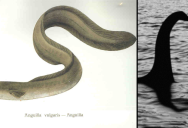Could “Super” Eels Explain The Loch Ness Monster?
The mystery of the loch ness monster has endured for centuries, because everyone loves a good mystery.
If it includes a potentially huge but probably benign monster, so much the better, right?
Now, some think that the answer to “Nessie’s” identity could be as easy as tracking down a “super” eel.

Image Credit: iStock
The “eel hypothesis” suggests that European eels, particularly the giant Anguilla anguilla could be able to trick the eye enough to make them appear to people as the Loch Ness monster.
Guesses on the monster’s size range from 3.3-6.6 feet based on the Surgeon’s Photograph, and go up to 49-66 feet if you’re using the Flipper Photograph for reference.
The authors of the new study (and the theory) claim that if Nessie is on the smaller size, there could be several of them in a body of water the size of Loch Ness.
“Thus, if there are any, there may be many. If it’s real, could it be an eel?”
The researchers looked at data from the loch to figure out how many eels have been pulled out of the water, and what sizes were documented. Most of them are on the smaller size, leading them to conclude the chances of seeing a large one would be on the rare side.

Image Credit: Public Domain
“However, this is not quite the ‘monster postulated.’ Indeed, the probability of finding a 6-meter [20-foot] eel in Loch Ness is essentially zero; too low for the software used to provide a reliable estimate. Thus, while large eels may account for some eyewitness sightings of large, animate objects rising to the loch surface, they are unlikely to account for ‘sightings’ of extraordinarily large animals, which may be accounted for by wave phenomena, the occasional stray mammal, or other.”
If it’s unlikely, then why are we talking about this hypothesis at all?
Well, because this modern data doesn’t line up with past studies of eels in the loch, which include lots of material from A. anguilla, which does grow to those larger sizes quite regularly.
And, you know. The shape really checks out.
So, the jury is still out – and personally, I think that’s how people secretly like it.

Sign up to get our BEST stories of the week straight to your inbox.




